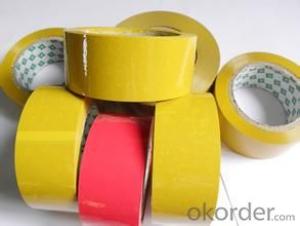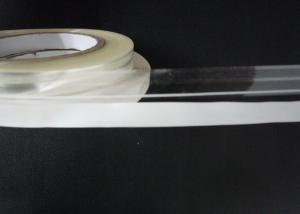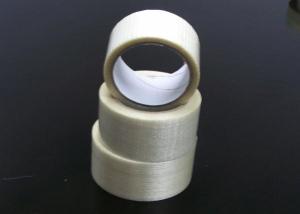Clear OPP Adhesive Packaging Tape with Cold Heat and Aging Resistance Cloth Tape
- Loading Port:
- Shanghai
- Payment Terms:
- TT OR LC
- Min Order Qty:
- 10000 m²
- Supply Capability:
- 20000000 m²/month
OKorder Service Pledge
OKorder Financial Service
You Might Also Like
Specifications
·World Top 500 Enterprises
·Resistance to cold, heat and aging
·Best quality and competitive price
·SGS&ISO9001
Description
The Cloth Tape is of polyethylene cloth as the carrier, coating with hot melt adhesive, synthetic rubber adhesive or nature rubber. It is excellent in flame retardant, high temperature stability, and anti-aging. It provides well insulation to various products.
General purpose of Cloth Tape: widely used for pipe wrapping, gaffers and book binding etc.
Typical Physical Reports of Bopp Tape

The thickness of the tape can be customized.
Log Roll: Length 1000mm; width 1060mm.
Cut Roll: As per customer’s requirements


FAQ of Double Sided Tissue Tape
Q1. How about your company?
CNBM International Corporation (CNBM International) is a state-owned company and we have sound business relations with clients from over 120 countries. Currently, we have wholly-owned overseas subsidiaries and branches in 5 countries with a view to realize localization, which also represents an essential progress in our globalization target. We have over twenty years experiences.
Q2. What kind of service we can provide for you?
Sample of Cloth Tape is available.
Your inquiry will be replied within 12 hours.
24 hours service for you
Well-trained & experienced sales representative are ready to answer you.
Q3. How long can you receive the product?
Within 7-15 working days after receiving your deposit
Welcome to contact us and visit the factory!
- Q: Is packaging tape flammable?
- Packaging tape, in general, does not easily catch fire. The majority of packaging tapes are composed of materials such as polypropylene or polyester, which possess elevated melting points and are highly flame-resistant. Nevertheless, it is crucial to acknowledge that the adhesive utilized on the tape can differ depending on the specific brand and type. Certain adhesive compositions may contain elements that are flammable; however, these elements are typically found in minuscule quantities and are improbable to pose a significant risk of causing a fire. Nevertheless, it is always advisable to adhere to the manufacturer's instructions and maintain a safe distance between packaging tapes and open flames or potential ignition sources to ensure one's safety.
- Q: Is packaging tape safe to use on stainless steel?
- Yes, packaging tape is generally safe to use on stainless steel as it does not usually cause any damage or leave adhesive residue. However, it is always recommended to test a small, inconspicuous area first to ensure there are no adverse reactions or issues with the specific type of tape being used.
- Q: Can packaging tape be printed with custom logos or designs?
- Yes, packaging tape can be printed with custom logos or designs. This allows businesses to personalize their packaging and promote their brand identity. Custom printed packaging tape can also serve as a marketing tool by creating a professional and eye-catching appearance for packages.
- Q: Can packaging tape be used for sealing packages with fragile artwork or sculptures?
- Yes, packaging tape can be used for sealing packages with fragile artwork or sculptures. However, it is important to choose the right type of packaging tape to ensure the protection of the artwork. Generally, it is recommended to use a high-quality, heavy-duty packaging tape that is specifically designed for shipping and handling delicate or fragile items. These tapes are often reinforced with fibers or have extra adhesive strength to provide a secure seal and prevent damage during transportation. Additionally, it is advisable to use proper cushioning materials such as bubble wrap or foam padding to protect the artwork inside the package.
- Q: Can packaging tape be used for sealing plastic storage bins?
- Indeed, plastic storage bins can be effectively sealed using packaging tape. The tape is specifically engineered to possess robust adhesion, making it an ideal choice for securing and sealing a wide range of materials, including plastic bins. Its dependable and long-lasting seal guarantees the security and protection of the bin's contents. Nevertheless, it is crucial to carefully and firmly apply the tape in order to achieve a tight seal. Moreover, it is advisable to utilize a high-quality packaging tape that is specifically tailored for the intended purpose to obtain the best sealing outcomes.
- Q: Are there any specialty packaging tapes for specific applications?
- Yes, there are specialty packaging tapes available for specific applications. These tapes are designed to cater to specific needs and requirements in various industries. Some examples of specialty packaging tapes include: 1. Double-sided tapes: These tapes have adhesive on both sides and are commonly used for mounting purposes, such as attaching posters or signs to surfaces. 2. Tamper-evident tapes: These tapes leave a visible mark or pattern when removed, indicating that the package has been tampered with. They are commonly used for sealing sensitive or valuable items during transportation. 3. Filament tapes: These tapes have fiberglass strands embedded in them, providing high tensile strength. They are commonly used for bundling heavy items or reinforcing packages that require extra strength. 4. Masking tapes: These tapes have low adhesive strength and are easily removable without leaving residue or damaging surfaces. They are commonly used for masking off areas during painting or for temporary holding applications. 5. Printed tapes: These tapes can be customized with specific messages, logos, or branding to enhance the presentation of packages and promote brand awareness. 6. Cold temperature tapes: These tapes are designed to withstand extremely low temperatures and are commonly used in cold storage facilities or for shipping goods that require refrigeration. 7. Hazard warning tapes: These tapes are brightly colored and have warning messages or symbols printed on them. They are commonly used to mark hazardous areas or indicate potential dangers. These are just a few examples of the many specialty packaging tapes available in the market. Each tape is designed to meet specific requirements, ensuring the safe and secure packaging of different products or materials in various industries.
- Q: Does packaging tape leave residue?
- Yes, packaging tape can leave residue on surfaces. This is because most packaging tapes are adhesive and are designed to stick securely to surfaces. When the tape is removed, it can leave behind a sticky residue that may be difficult to remove. The residue can accumulate dust and dirt, making it even more challenging to clean. However, there are some packaging tapes available that are specifically designed to leave little to no residue when removed. It is always a good idea to test a small area before using packaging tape on delicate or valuable surfaces to ensure that it does not leave any unwanted residue.
- Q: Is packaging tape easy to remove without damaging surfaces?
- Yes, packaging tape is generally easy to remove without damaging surfaces. It is designed to adhere securely to packages, but also to be easily peeled off without leaving residue or causing damage to most surfaces.
- Q: Food packaging, sealing tape printing and product manufacturers inconsistent with the use of it?
- It depends on whether it's an individual case or a whole lot of products,If it is a case, replacement is, and probably the supermarket will pay some money on behalf of, but not too much,If the whole batch of products are so, the problem is great, from the quality supervision point of view, at least the label failed, and from the industrial and commercial point of view is fraudulent consumers, manufacturers trouble,
- Q: Is packaging tape safe to use on mirrors?
- Yes, packaging tape is generally safe to use on mirrors. It is a strong and adhesive tape that is designed to securely hold items together. However, it is important to note that the type of packaging tape used can affect its safety for use on mirrors. Clear packaging tapes or tapes specifically designed for glass surfaces are typically the best options to avoid any potential damage or residue left on the mirror. Additionally, it is recommended to test a small, inconspicuous area of the mirror before applying the tape to ensure it adheres well and does not cause any damage.
Send your message to us
Clear OPP Adhesive Packaging Tape with Cold Heat and Aging Resistance Cloth Tape
- Loading Port:
- Shanghai
- Payment Terms:
- TT OR LC
- Min Order Qty:
- 10000 m²
- Supply Capability:
- 20000000 m²/month
OKorder Service Pledge
OKorder Financial Service
Similar products
Hot products
Hot Searches




























